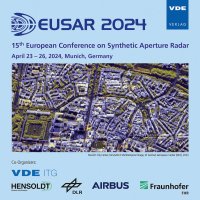Experimental Demonstration of a High-Resolution Ultra-Wide-Swath Imaging Mode for Ship Monitoring Based on Continuous PRF Variation and Alternated Up- and Down-Chirp Waveforms
Conference: EUSAR 2024 - 15th European Conference on Synthetic Aperture Radar
04/23/2024 - 04/26/2024 at Munich, Germany
Proceedings: EUSAR 2024
Pages: 6Language: englishTyp: PDF
Authors:
Ustalli, Nertjana; Nogueira Peixoto, Maxwel; Kraus, Thomas; Steinbrecher, Ulrich; Krieger, Gerhard; Villano, Michelangelo
Abstract:
Maritime surveillance using synthetic aperture radar (SAR) calls for both a wide swath and high resolution. This allows for the monitoring of wide areas with high detection probabilities and low false alarm rates at short time intervals. Ambiguous SAR modes, such as the staggered ambiguous mode utilizing continuous variation of short pulse repetition intervals and the low pulse repetition frequency mode, have proven effective for ship monitoring. This is especially true in remote offshore regions. Both modes, can image a wide swath with high azimuth resolution without the need of digital beamforming or multiple apertures, as ambiguities of the ships can be tolerated. Building upon the successful demonstration of the staggered ambiguous mode using experimental data acquired by the TerraSAR-X satellite, this paper presents a further demonstration. We achieve ultra-wide swath imaging, extending the ground swath width from 110 to 160 km, while maintaining the same high azimuth resolution of 2.2 m. Furthermore, we extend the application of the ambiguous mode to coastal areas. This achievement is accomplished by introducing in the staggered ambiguous mode an alternation of up- and down-chirp waveforms. An experimental acquisition was carried out over a scene located in the North Sea and including part of the Dutch coast. Compared to the TerraSAR-X ScanSAR mode, a swath width larger by 50% and an azimuth resolution eight times better are achieved. Despite the presence of first-order range ambiguities caused by land scatterers, the detection of small ships remains feasible, as these ambiguities are very blurred and manifest as noise-like disturbances. These results are of fundamental importance for incorporating the ambiguous modes into existing and future SAR systems as an efficient additional mode for ship monitoring, suitable for both open sea and coastal surveillance.


